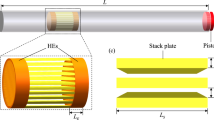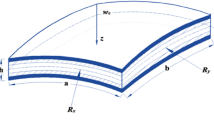Abstract
This paper investigates the nonlinear free vibration of a marine riser with large displacement. The nonlinear equation of motion is derived using a variational approach based on Hamilton’s principle. The strain energy functional is composed of the strain energies due to axial deformation and bending. The strain energy associated with the rotational restraint at the bottom end of riser is also considered. The kinetic energy is derived by considering the riser and transporting fluid motions. The finite element method is applied to develop the nonlinear stiffness matrix, mass matrix, and gyroscopic matrix of the riser system. Consequently, the nonlinear natural frequencies and their corresponding mode shapes are determined by solving the eigenvalue problem incorporating the direct iteration technique. Various numerical examples are investigated to evaluate the linear and nonlinear dynamic characteristics of the riser. The parametric investigations of the horizontal top end offset, top tension, and rotational spring constant at bottom support are provided to show the modal transition phenomenon of the riser system. The nonlinear natural frequencies and their corresponding mode shapes are also presented to identify the softening and hardening behaviors of the riser.










Similar content being viewed by others
References
Doan VP, Nishi Y (2015) Modeling of fluid-structure interaction for simulating vortex-induced vibration of flexible riser finite difference method combined with wake oscillator model. J Mar Sci Technol 20:309–321
Gu J, Vitola M, Coelho J, Pinto W, Duan M, Levi C (2013) An experimental investigation by towing tank on VIV of a long flexible cylinder for deepwater riser application. J Mar Sci Technol 18(3):358–369
Riveros C, Utsunomiya T, Maeda K, Itoh K (2010) Response prediction of long flexible risers subject to forced harmonic vibration. J Mar Sci Technol 15(1):44–53
Wang K, Xue H, Tang W, Guo J (2013) Fatigue analysis of steel catenary riser at the touch-down point based on linear hysteretic riser–soil interaction model. Ocean Eng 68:102–111
Dareing DW, Huang T (1976) Natural frequency of marine drilling riser. J Petro Tech 28:813–818
Kirk CL, Etok EU, Cooper MT (1979) Dynamic and static analysis of a marine riser. Appl Ocean Res 1(3):125–135
Kim YC, Triantafyllou MS (1984) The nonlinear dynamics of long slender cylinders. J Energy Resour Technol ASME 106(2):250–256
Moe G, Chucheepsakul S (1988) The effect of internal flow on marine risers. In: Proceedings of the 6th international offshore mechanics and arctic engineering symposium, Houston, 7–12 Feb
Cheng Y, Vandiver JK, Moe G (2002) The linear vibration analysis of marine risers using WKB-based dynamic stiffness method. J Sound Vib 251(4):750–760
Chen Y, Chai YH, Li X, Zhou J (2009) An extraction of the natural frequencies and mode shapes of marine risers by the method of differential transformation. Comput Struct 87(21–22):1384–1393
Chucheepsakul S, Huang T (1989) Natural frequencies of a marine riser in three-dimensions. In: Proceedings of the 7th international offshore mechanics and arctic engineering symposium, pp 651–658
Chai YT, Varyani KS, Barltrop NDP (2002) Three-dimensional lump-mass formulation of a catenary riser with bending, torsion and irregular seabed interaction effect. Ocean Eng 29(12):1503–1525
Chucheepsakul S, Huang T, Monprapussorn T (2003) Large strain formulations of extensible flexible marine pipes transporting fluid. J Fluids Struct 17(2):333–365
Chai YT, Varyani KS (2006) An absolute coordinate formulation for three-dimensional flexible pipe analysis. Ocean Eng 33(1):23–58
Athisakul C, Monprapussorn T, Chucheepsakul S (2011) A variational formulation for three-dimensional analysis of extensible marine riser transporting fluid. Ocean Eng 38(4):609–620
Gay Neto A, Martins CA, Pimenta PM (2014) Static analysis of offshore risers with a geometrically-exact 3D beam model subjected to unilateral contact. Comput Mech 53:125–145
Wang JL, Duan ML (2015) A nonlinear model for deepwater steel lazy-wave riser configuration with ocean current and internal flow. Ocean Eng 94:155–162
Aguiar LL, Almeida CA, Paulino GH (2015) Dynamic analysis of risers using a novel multilayered pipe beam element model. Marine Struct 44:211–231
Kaewunruen S, Chiravatchradej J, Chucheepsakul S (2005) Nonlinear free vibrations of marine risers/pipes transporting fluid. Ocean Eng 32(3–4):417–440
Athisakul C, Huang T, Chucheepsakul S (2002) Large strain static analysis of marine risers via a variational approach. In: Proceedings of the 12th international offshore and polar engineering conference, Kitakyushu, Japan, pp 164–170
Monprapussorn T, Athisakul C, Chucheepsakul S (2007) Nonlinear vibrations of an extensible flexible marine riser carrying a pulsatile flow. J Appl Mech 74(4):754–769
Prathap G, Varadan TK (1978) The large amplitude vibration of hinged beams. Comput Struct 9:219–222
Singha MK, Ganapathi M (2004) Large amplitude free flexural vibrations of laminated composite skew plates. Int J Non-Linear Mech 39(10):1709–1720
Athisakul C, Klaycham K, Chucheepsakul S (2014) Critical top tension for static equilibrium configuration of a steel catenary riser. China Ocean Eng 28(6):829–842
Woinowsky-Krieger S (1950) The effect of an axial force on the vibration of hinged Bars. J Appl Mech 17:35–36
Sarma BS, Varadan TK (1983) Lagrange-type formulation for finite element analysis of nonlinear beam vibrations. J Sound Vib 86(1):61–70
Chucheepsakul S, Srinil N (2002) Free vibrations of three-dimensional extensible marine cables with specified top tension via a variational method. Ocean Eng 29(9):1067–1096
Srinil N, Rega G, Chucheepsakul S (2003) Large amplitude three-dimensional free vibrations of inclined sagged elastic cables. Nonlinear Dyn 33(2):129–154
Karnovsky IA, Lebed OI (2001) Formulas for structural dynamics: tables, graphs, and solutions. McGraw-Hill, New York
Pesce CP, Aranha JAP, Martins CA, Ricardo OGS, Silva S (1998) Dynamic curvature in catenary risers at touchdown point: An experimental study and boundary-layer solution. Int J Offshore Polar Eng 8(4):303–310
Acknowledgments
The authors gratefully acknowledge the financial support by the Thailand Research Fund (TRF) and King Mongkut’s University of Technology Thonburi under Contract No. TRG5680077.
Author information
Authors and Affiliations
Corresponding author
Appendix 1
Appendix 1
From the position vector \({\mathbf{\overset{\lower0.5em\hbox{$\smash{\scriptscriptstyle\rightharpoonup}$}} {r} }}^{*}\) shown in Eq. 7, its derivative with respect to \(s\) and the application of the Frenet formulas lead to
According to the theory of elasticity, the dynamic axial strain is given by
where \({\text{d}}s\) and \({\text{d}}s^{ * }\) are infinitesimal arc lengths of the riser at the static state and the dynamic state, respectively. Therefore, the derivative of the parameter with respect to \(s\) is related to the one with respect to \(s^{ * }\) by
Based on the differential geometry of a curve, the unit tangent vectors (see Fig. 1) at the static state \(\left( {\hat{t}} \right)\) and the dynamic state \(\left( {\hat{t}^{ * } } \right)\) are defined by
Using Eqs. 39 and 44 with some manipulations, the unit tangent vector at dynamic state can be expressed in terms of the displacements as:
The angle \(\left( {\theta_{\text{d}} } \right)\) between the unit tangent vectors \(\hat{t}\) and \(\hat{t}^{ * }\) can be obtained by considering direction cosine in Eq. 45 as:
Utilizing Taylor series, \(\theta_{\text{d}}\) can be approximated keeping the nonlinear terms of displacement up to second order as:
About this article
Cite this article
Klaycham, K., Athisakul, C. & Chucheepsakul, S. Nonlinear vibration of marine riser with large displacement. J Mar Sci Technol 22, 361–375 (2017). https://doi.org/10.1007/s00773-016-0416-8
Received:
Accepted:
Published:
Issue Date:
DOI: https://doi.org/10.1007/s00773-016-0416-8




